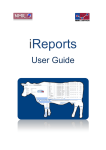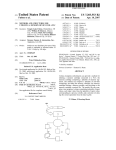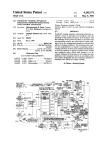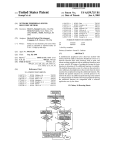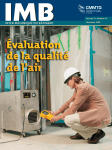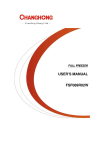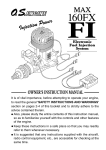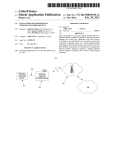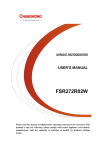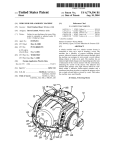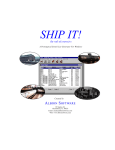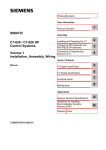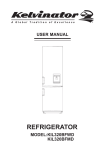Download Insect eradication system and method
Transcript
US007926222B2 (12) United States Patent (10) Patent N0.2 Molnar et al. (54) (45) Date of Patent: INSECT ERADICATION SYSTEMAND 4,620,388 A * 4,642,441 A * 2/1987 4,676,152 A * 6/1987 Tsujiet a1. .. 4,692,593 A 9/1987 . Inventors: Christopher J. Molnar, Coraopol1s, PA (US); Paul R- Rannlck, Munhall, PA (US); Torn Jarzynka, Geneva, FL (US) * Notice: M988 lmagawa ’ . 99/468 392/373 43/l30 392/365 Forbes- ............. .. 219/536 .. 43/132.1 _ghigldoln or es """""""""""" et al' "~~ ' (Con?rmed) FOREIGN PATENT DOCUMENTS 19746026 A1 * Sep. 25, 2008 6/1998 (Continued) Pl‘iOl‘ Publication Data n 4/1989 2 i DE Us 2010/0071258 A1 I t Cl 392/365 ......... .. 4/1988 You .................. .. ’ (21) App1_ No; 12/284,826 (51) Chiu 4,716,676 A ,1 U.S.C. 154(1)) by 118 days. (65) Kenyon .... .. 4,794,227 A * 12/1988 AntoniaZZiet a1. patent Subjectistoextended any disclaimer, or adjusted the term under ofthis 35 (22) Filed: 11/1986 ImagaWa ...................... .. 43/130 4,740,670 A * 4,817,329 A * (*) Apr. 19, 2011 METHOD . (76) US 7,926,222 B2 OTHER PUBLICATIONS Mar‘ 25’ 2010 International Search Report and Written Opinion, Application No. PCT/US2009/05279, dated Nov. 17, 2009 (10 pages). . A01M1/20 (2006.01) (Continued) (52) US. Cl. ....................................... .. 43/132.1; 43/124 (58) Field of Classi?cation Search ............... .. 43/1321, _ Pr’mary Exammer * Darren W Ark 43/124, 130, 144, 125, 129; 392/365, 373, (74) Allow/82488111. 0r Flrm * K&L Gates LLP 392/349, 350; 219/385, 386, 5364541; 165/122 See application ?le for complete search history. (57) ABSTRACT _ References Clted System, kit, and method for treating bed bugs or other pests in a room. The system comprises an electric heater that is US. PATENT DOCUMENTS formed by joining separate parts or sections. A ?rst heater section may comprise a number of electrically energized (56) 1,817,535 A * 8/1931 1,948,228 A * 2/1934 Urban 2,467,393 4/1949 A * Spanel .......................... .. 43/124 43/132.1 Leher . . . . . . . . . . . . . . . . . . .. 43/132.1 2,469,963 A * 5/1949 Grosjean et al. . 3,029,332 * 4/1962 Cotts 3,378,065 A * 4/1968 Mitchell et al. .... .. 165/122 Brasch . . . . .. 3,631,525 _ A * 12/1971 3,731,057 A * 3,737,622 A * A 5/1973 6/1973 . . . . . . . . . . . . . . . . . . . . . . . . . KunZ et al. Hallgreen 43/124 . . . . .. 392/350 392/350 .... .. 392/368 .... .. 392/360 3,870,860 A * 3/1975 Steiner ..... . . . . .. 392/351 3,924,099 A * 12/1975 Housel . .... ... . . . . . .. 165/122 4,476,920 A * 10/1984 Drucker et al. .. 4,523,081 A * 6/1985 Geib etal. heater coils and the second section may comprise a fan and a fan motor. The system may also comprise a number of tem perature-sensing probes to be installed at locations Within the room. The system may also comprise an electronic data recorder to receive and record temperature readings from the temperature-sensing probes. The room may be gradually heated to a temperature that is lethal for bed bugs and other pests. Once the lethal temperature is reached, the room may be heated for a time period. .... .. 165/242 .................. .. 392/350 Position Temperature Senslng Probes Connect Probes to Data Recorder Operator Leave Roam; Close and Seal Door Heat Room to Lethal Temperature 24 Claims, 6 Drawing Sheets US 7,926,222 B2 Page 2 US. PATENT DOCUMENTS 2001/0034963 Al* 11/2001 Jones ............................ .. 43/124 * 4,989,363 A * M991 Doememann """"""" " 43mm 4,989,364 A * 2/1991 Chaudoln etal. . 5,083,011 A * 1/1992 . 392/365 6/1992 ~ 165/122 * 7/1992 . 5,203,108 A * 4/1993 43 “321 5,349,778 A * 9/1994 43/1321 5,378,086 A * 1/1995 Campbell et al. . ’ A ’ 5,501,032 A * 5,678,352 A * * 2002/0189154 A1 ,, 2002/0194773 A1 2/2003 To 131/299 2004/0025893 Al* 2/2004 131/299 ,, ,, 2/2004 Topp 1/2005 Hedman * 2005/0108920 A1 5,805,767 A 9/1998 . 392/365 * 6,141,901 A * 11/2000 * 11/2000 6,169,850 Bl* 1/2001 Menassa . 392/350 6,233,397 Bl* 5/2001 o?n ......... .. . 392/373 4/2002 . . 219/385 6,447,737 Bl* 9/2002 W1ll1amson etal. 43/124 6,588,140 Bl* 6,612,067 B2* 7/2003 Johnson etal. 43/132.1 9/2003 Topp ,,,,,,,,,,,,,,,,,,,,,,,,,,,,, ~ 43/124 . . 6,678,994 B2* 1/2004 6,772,829 B2* 8/2004 Lebrun 6,840,256 Bl* 1/2005 Ryan etal. 43/125 5/2005 Hedman .. 43/132.1 7,134,239 B2* 2007/0084105 A1 ,, * * 2007/0283986 A1 2008/0014111 A1 ,, 2008/0148624 A1 ,, .. 43/124 ....... .. Hedman ......................... .. 422/1 11/2005 Mueller et al. .. 4/2007 Lindsayetal. . 12/2007 Baum 1/2008 ........ .. A1 ,, 2009/02m48 A1,, .. 43/124 43/132.1 .. 43/124 Hedman .. 6/2008 Bonn etal. .. 2008/0260364 A1 * 10/2008 Vandrak etal. . 2009/0071062 422/3 Takenoshltaetal. ...... .. 43/132.1 5/2005 10/2005 3/2009 Hedman .... .. 422/3 43/132.1 392/365 .. 43/132.1 8,2009 Mccm 43,124 y FOREIGN PATENT DOCUMENTS Topp ............................. .. 43/124 . 165/122 422/1 422/307 " * DE 19936417 A1 2/2001 OTHER PUBLICATIONS Barra ............... .. 43/144 7,407,624 132* 80008 Cumberland et a1‘ 42208 User Manual, ECRl Paperless Recorder, Chromalox, Inc., 12th 7,435,378 B2* 7,690,148 B2* 10/2008 Richardson etal. .. 4/2010 Hedman ...... .. 43/124 43/ 132.1 ed~,Feb~2006~ “Portable Industrial Unit Blower Air Heater, Types SDRA and 7,739,829 B2* 7,837,932 B2* 2001/0004813 Al* 11/2006 2005/0246942 A1 43/125 43/132.1 Far1esetal. ...... .. 6,892,491 B2* 2005/0220662 A1 .................. .. 43/124 6,279,261 Bl* 8/2001 Blnkeretal. 6,327,812 Bl* 12/2001 Hedmanetal. . 6,376,805 B2* 2005/0013727 A1 Johnson etal. ............ .. 43/132.1 . . W1ll1amson Kreyenberg . Hedman 2004/0035044 A1 " 2/2004 Hedman 2/2004 43/124 6,146,600 A 43/124 2004/0028583 A1 * 8/1998 W1ll1amson etal. ...... .. .. 43/124 2/2004 Kreyenberg . 5,792,419 A * Jouasetal. Hedman .................... .. 43/132.1 Topp ............................. .. 43/124 2003/0026727 Al* 43/132.1 43/124 . Topp .......... .. 12/2002 12/2002 2004/0025892 Al* 2004/0028554 A1 ,, 43/124 .. 43/124 11/2002 pp """ " ' . 6/2002 Hedmanetal. 165/122 Pitrnan ...... .. . Le1tneret al. .... .. * 3/1996 10/1997 2002/0170227 A1 43/132.1 5,121,788 A * 5131461 2002/0066223 Al* 6/2010 Chen et a1. ................. .. 43/1321 11/2010 ,, ,, SDRA-RG,”ChromaloX,Inc., 2006. Hedman .................... .. 43/132.1 6/2001 Hedman .................... .. 43/132.1 * cited by examiner US. Patent Apr. 19, 2011 5 FIG. 4 56 Sheet 1 of6 5%,, US 7,926,222 B2 US. Patent Apr. 19, 2011 Sheet 2 of6 -. , $1; " . KKKKQQ US 7,926,222 B2 US. Patent Apr. 19, 2011 Sheet 3 of6 US 7,926,222 B2 US. Patent Apr. 19, 2011 US 7,926,222 B2 Sheet 4 0f 6 ,\/ 100 5/ 102 /\/ 104 ,\/ 106 ,\/ 108 ,\/ 110 b/ 112 Prepare Room V Position Temperature Sensing Probes Connect Probes to Data Recorder Turn Heater On V Operator Leave Room; Close and Seal Door V Heat Room to Lethal Temperature V Turn Heater Off FIG. 9 US. Patent Apr. 19, 2011 Sheet 5 of6 US 7,926,222 B2 w§\ w? 5?E? KnWUE O “EEmaSm _. /¢N_\/u x US. Patent 50.E5mLES: Apr. 19, 2011 UNNQNN 586:95; moN Sheet 6 of6 US 7,926,222 B2 US 7,926,222 B2 1 2 INSECT ERADICATION SYSTEM AND METHOD Even so, the presence of bed bugs in a room is generally perceived by the public as an indication of improper sanita tion and poor cleanliness. Over the years, many techniques have been proposed for eliminating and preventing craWling insect pests such as BACKGROUND cockroaches and ants in homes and businesses. These tech Bed bugs are nocturnal insects that feed only on blood, mainly on the blood of humans. Bed bugs Will suck blood niques focus on the minimal application of pesticides and placement of products in areas that humans and pets cannot from other animals, such as domestic pets, as Well as pests such as birds and bats. They live in loose groups or individu ally and have a tendency to occupy cracks and crevices or other similar harborages. Bed bugs are stimulated to seek a come into contact With them. Unfortunately, these modern techniques have proven to be very ineffective against the common bed bug. Being blood feeders, bed bugs are not attracted to any current formulated baits, and currently there host most likely by vibrations, body heat, and CO2 vapors. An are no synthetic pheromones that could be used as attractants inseminated adult female bed bug requires a blood meal Within ?ve days either before or after insemination for egg laying to occur. Once fed and inseminated, the female bed bug locates a suitable environment and deposits small, Whitish to traps, Which further reduces the treatment strategies and options available to the modern pest management profes sional. The piercing mouthpart does not enable bed bugs to groom themselves or each other, Which can limit effective ness of dust formulations. eggs, Which are attached With a cement-like material to sur faces in the cracks and crevices Where they hide. Eggs can be found in caches in protected areas as Well as individually in open spaces. Females typically lay 2-3 eggs per day and can lay 200 to 500 eggs in their lifespan. Under appropriate tem peratures, eggs hatch after approximately 10 days but may be viable for as long as 28 days before hatching. Bed bug nymphs molt 5 times before reaching adulthood and require a US. Pat. No. 6,141,901 discloses one prior art technique 20 treating pests, including insects. The technique of this patent 25 involves pumping heated outside air into the treatment Zone (e.g., a structure) for a period of time. The outside air is heated to at least 2000 F. and pumped into the structure until the temperature inside the structures rises, preferably at a rate of 10° F. per hour, until the temperature inside the structure reaches the lethal temperature, Which, according to the patent, blood meal prior to each molt. Adults can live Without a meal for several months (in some reports, for more than a year) and nymphs for up to four months Without feeding. The time for development of each instar is dependant upon and available food source (host), temperature and humidity. With an available host, the ideal environment for develop is usually about 120° F. to 130° F. for most pests. US. Pat. No. 6,588,140 discloses another prior art tech nique for treating articles for pest infestation. In this patent, 30 ?exible, heat-resistant material, and hot air is pumped into the ment is 83° F. to 90° F. With 75% to 80% relative humidity. Under these conditions, all ?ve nymph stages can be com pleted and sexual maturity reached in approximately 45-60 days. There is potential for 3-4 generations per year to be 35 During the nymphal development stages, bed bugs may feed as frequently as once a day and usually feed at night 40 (piercing mouthpart) penetrates the skin and a feeding tube 45 the penetration of the skin. The bed bug injects an anticoagu lant into the Wound to facilitate feeding. During the night, the insect may feed at several different points along the body before becoming fully engorged. Feeding is most often done horiZontally across skin of the host as the insect travels along the sheets or other bedding. Bed bugs rest betWeen feedings in Whether or not a customer may get them in the ?rst place. 100° F. and 400° F. SUMMARY 55 In one general aspect, the present invention is directed to systems and method for treating bed bugs or other pests in a room of a multi-room building, such as a hotel, apartment building, of?ce building, etc. According to various embodi or a host becomes available. Bed bugs are of particular concern in the hospitality indus try. A hotel’s reputation for service and cleanliness is the driving factor in their quality rating and booking of room space. Therefore, bed bugs can be devastating to the hotel’s reputation and create an immediate negative ?nancial impact. While sanitation can play a role in the level of dif?culty controlling a bed bug infestation, it has little to do With in a room of a multi-room building. According to this pub lished application, a heater is placed Within the room of the building and heat sensitive articles Within the room are removed. In addition, a number of temperature-sensing probes are positioned in the room. The heater then heats the ambient air Within the room to a predetermined temperature, as measured by the temperature-sensing probes, of betWeen 50 protected areas near the location of a host aWaiting a stimulus to signal them to seek their next meal. Under consistent mod erate room temperatures and an adequate food supply bed bugs Will live to 316 days. LoW temperatures and/or an incon sistent food supply can actually extend the life span of stressed bed bugs up to 1 years as their metabolism sloWs (hibernation) and then returns to normal as temperatures rise sure reaches about 120° F. Published US. patent application Pub. No. 2005/0220662 discloses a process for killing organisms, including bed bugs, 3 to 12 minutes to feed to engorgement. To feed, the proboscis Within the proboscis is extended and attached to a capillary. The person or animal being fed upon typically does not feel enclosure. US. Pat. No. 6,327,812 discloses a process for killing organisms and removing toxins in an enclosure. In the process of this patent, temperature-sensing probes are installed Within the enclosure. Hot air, produced by a heater external to the enclosure, is then introduced into the enclosure through one or more ingress ducts until the temperature Within the enclo produced. When people are asleep; hoWever, they Will seek blood meals during the day under subdued or loW light situations. It takes the articles to be treated are placed in an enclosure, Which envelopes the articles. The enclosure is then sealed With a 60 ments, the system comprises an electric heater that is formed by joining separate parts or sections. A ?rst heater section may comprise a number of electrically energized heater coils and the second section may comprise a fan and a fan motor. The fan motor is for poWering the fan, and the ?rst heater section is connectable to the second heater to form the electric heater to heat the room. The system may also comprise a 65 number of temperature-sensing probes to be installed at loca tions Within the room to measure the temperature in the room. The system may also comprise an electronic data recorder in US 7,926,222 B2 3 4 communication With the plurality of temperature-sensing probes to receive and record temperature readings from the FIG. 2 is diagram of a second section of a heater according to various embodiments of the present invention; FIGS. 3-6 are vieWs of an assembled heater according to plurality of temperature-sensing probes. various embodiments of the present invention; The room may be gradually heated to a temperature that is lethal (“the lethal temperature”) for bed bugs and other pests. FIG. 7 is a diagram of a heater element, comprise a number According to various embodiments, the room may be heated of heater coils, according to various embodiments of the so that the ambient air in the room is at least 1200 F. and the present invention; FIG. 8 is a diagram of a control panel of the heater accord temperature of structural voids in the Walls, ceiling, etc., of the room is at least 1110 F. Once the lethal temperature is ing to various embodiments of the present invention; reached, the room may be heated for a time period (“the FIG. 9 is a ?owchart illustrating a process for treating a room according to various embodiments of the present inven treatment time period”), such as tWo to four hours or more, in tion; order to kill the bed bugs and other pests in the room. After the treatment time period, the heater may be turned off and the FIG. 10 is a diagram of a system for treating a room according to various embodiments of the present invention; room alloWed to return to normal temperature. and FIG. 11 is a Wiring diagram of the heater according to various embodiments of the present invention. According to various embodiments, the method may com prise preparing the room for treatment. Preparing the room for treatment may comprise, for example: (i) moving furni ture to the center of the room and aWay from the Walls; (ii) modifying or deactivating Water sprinkler and smoke detec DESCRIPTION 20 tion systems; and (iii) fully and tightly closing the WindoWs of The present invention is directed generally to systems and methods for treating a room for pests. The pests may be, for example, bed bugs or other insects or microorganisms. Pref the room. The process of treating the room may also include placing the temperature-sensing probes at various strategic erably, the treatment of the room kills or eradicates mo st if not locations throughout the room. The plurality temperature sensing probes are also in communication With a data 25 all of the pests in the room. In addition, the room is preferably recorder that records the temperature readings. The process a room of a multi-unit or multi-room building, such as a hotel, also comprises connecting a ?rst heater section to a second, separate, heater section to form an electric heater. The ?rst hospital, o?ice building, etc. That Way, the process can be used to treat individual rooms of the building rather than the entire building at once. In addition, although the description heater section comprises a plurality of electrically energiZed heater coils, and the second heater section comprises a fan and a fan motor. In addition, the process comprises heating the room, With the electric heater, such that ambient air in the 30 limited and the heating process could be used in various embodiments to treat individual structures, such as single room is heated to at least 1200 F. for a treatment time period and such that interior structural voids for the room exceed 1110 F. for the treatment time period, Wherein the treatment time period is at least four hours in various embodiments. In herein is generally directed to embodiments Where one room in a multi-unit or multi-room building, the invention is not so family residences, etc. 35 addition, during the heating process, the energy gain may be monitored through the data recorder and by having a human The pest eradication process involves heating the ambient air in the room. The heating may be performed, in various embodiments, by an electric heater. The electric heater may comprise tWo or more separate sections that can be trans observer enter the room, make observations, and take surface temperatures at numerous different locations Within the room 40 ported separately, but combined or connected together to form a functioning electric heater. Employing multiple sepa (such as ?fteen to tWenty-?ve different locations). Such human observation may be done, for example, at one-hour rate sections has the advantage that the separate sections can intervals for the ?rst four hours and at tWo-hour intervals after four hours. heater sections easier to transport to rooms on upper levels of In other general aspect, the present invention is directed to a kit used for treating rooms With heat for eradicating bed bugs and other pests. The kit may comprise, according to various embodiments: (i) a ?rst heater section comprising a plurality of electrically energiZed heater coils; (ii) a second heater section, separate from the ?rst heater second, that be signi?cantly lighter than the Whole heater, making the buildings. In addition, as described beloW, in various embodi 45 ments one section of the heater may comprise a fan and fan motor, and another section may comprise the heater assem bly, including a number of heater coils. Certain heater coils may be rated for certain input voltage sources. Sectioning the 50 heater from the fan motor unit also alloWs for customiZation of the heater coils to match available poWer sources (e.g., poWer sources of 110V, 208V, 220V, 240V, 277V, etc.), With the recognition that the ohm rating of the coils limits the comprises a fan and a fan motor, Wherein the fan motor is for poWering the fan, and Wherein the ?rst heater section is con nectable to the second heater to form an electric heater to heat poWer selections. Once the separate heater sections have been the room; (iii) a plurality of temperature-sensing probes to be transported to the treatment area (e.g., the area or room to be installed at locations Within the room to measure the tempera 55 treated), the heater can be assembled from the various sec tions. FIGS. 1-7 shoW aspects of the electric heater according to various embodiments of the present invention. In the illus trated embodiment, the heater comprises tWo separate sec 60 tions. FIG. 1 shoWs a ?rst or front section 10 of the heater and FIG. 2 shoWs a second or rear section 12 of the heater. Both ture in the room; and (iv) a data recorder for communicating With the plurality of temperature-sensing probes to receive and record temperature readings from the plurality of tem perature-sensing probes. FIGURES sections 10, 12 may comprise generally cylindrical bodies 18, 19, Which may be made of metal, for example. The second Various embodiments of the present invention are described herein by Way of example in conjunction With the folloWing ?gures, Wherein: FIG. 1 is diagram of a ?rst section of a heater according to various embodiments of the present invention; section 12 may comprise a belt-driven fan 14 and an electric 65 motor 16 for poWering the fan 14 by driving the belt. The fan 14 may be located in the body 19 ofthe second section 12, and the motor 16 may be located under the body 19 (shoWn in US 7,926,222 B2 5 6 FIGS. 4 and 5). The ?rst section 10 may comprise a number panel 62, Which may be located on the upper surface of the poWer box 48, for example, as shoWn in FIG. 3. For example, of electrically energizable heater coils, Which When electri cally energized produce heat. The ?rst section 10 may com prise, for example, ten to tWenty separate heater coils. FIG. 7 shoWs an embodiment of a heater assembly 20 comprising ten heater coils 22.As described furtherbeloW, certain of the coils 22 may be connected to and electrically energized by various input poWer sources to the heater 24. The heater assembly 20 may be enclosed Within the body 18 of the ?rst section 10. FIG. 3 is a top vieW of the electric heater 24 With the ?rst and second sections 10, 12 connected to form the functional heater, and FIG. 4 shoWs a side vieW of the heater 24 With the ?rst and second sections 10, 12 connected. The ?rst and 5 lights 68, 70 respectively. Similarly, using sWitches 72-78, the user could turn on or off the poWer circuits 220d-e, and could also choose Whether they are to be poWered by 208/240V or 277V sources. Whether the poWer circuits 220d-e are opera tional or not may be indicated by indicator lights 80, 82 respectively As shoWn in FIG. 4, the heater 24 may include ?ve (5) external poWer cords. The ?rst external poWer cord 50 may connect to the poWer circuit 22011 that is used to provide electrical poWer to the motor 16. The ?rst poWer cord 50 may be connected to the poWer box 48, and a conduit 52 may carry the poWer cables from the poWer box 48 to the motor 16. The motor 16 may run on 120V, for example. As such, the ?rst poWer cord 50 may be plugged into a conventional 120V Wall second sections 10, 12 may be connected using, for example, conventional connecting means, such as nuts/bolts, etc. For example, the bodies 18, 19 may each include rims on their connecting ends that may be connected using nuts and bolts, or any other suitable connectors. As shoWn in FIGS. 3 and 4, each section 10, 12 may have one or more sets of Wheels 28 to facilitate transporting the sections 10, 12. Also, the sections 10, 12 may comprise feet 30 for supporting the end of the sections 10, 12 that do not have the Wheels 28. In other embodiments, one or both of the sections 10, 12 could have tWo sets of Wheels, With one set at each end of the section 10, 12. FIGS. 5 and 6 shoW front and back vieWs of the heater 24 using sWitches 64 and 66, the user could turn on or off the 120V poWer circuits 220b-c. Whether the poWer circuits 220b-c are operational or not may be indicated by indicator 20 outlet or to a 120V generator. The second tWo poWer cords 54, 56 may be used for 120V poWer sources, and may be connected to the tWo poWer cir cuits 220b-c of the poWer box 48 used to poWer the 120V 25 heater coils 2211 respectively. The other tWo poWer cords 58, 60, may be connected to the tWo poWer circuits 220d-e of the poWer box 48 andused to poWer the heater coils 22b-c respec according to various embodiments.As shoWn in these ?gures, the ?rst section 10 may include a front grill 40 through Which Which the fan 14 may pull ambient air for heating by the tively, but may be used for differently rated poWer sources, such as 240V and/or 277V, or any other voltage rating. In addition, the poWer box 48, as shoWn in FIG. 11, may comprise relays or other lockouts 210 for preventing the heater coils 22 from being energized unless the fan motor 16 heater assembly 20. is energized. Using the relay-type lockout 210 shoWn in FIG. The heater 24 may also include a poWer box 48. In the illustrated embodiment, the poWer box 48 is connected to the 11, the pole 212 is closed When the motor 16 is energized via the inductive coupling from the inductor 214, alloWing the hot air from the heater 24 can be bloWn. In addition, the second section 12 may include a rear intake grill 42 through body 18 of the ?rst heater section 10, although in other 30 35 embodiments, the poWer box 48 could be connected to the body 19 of the second heater section 12. The poWer box 48 may comprise, for example, ?ve separate electrical poWer circuits 220a-e, shoWn in FIG. 11. The ?rst poWer circuit 220a provides electric poWer to the motor 16. In the illustrate 40 embodiment, the ?rst poWer circuit 22011 is for poWering the motor 16 from a 120V poWer source. Also in the illustrate embodiment, the second and third poWer circuits 220b-c are for poWering individual, respective, 120V coils 22a from 120V input sources. The fourth and ?fth poWer circuits 45 tion and use depending on the available poWer sources. For 50 example, the user(s) could have one heater section 10 With some 120V heater coils (as shoWn in the embodiment described above) and could have a second heater section 10 With no 120V heater coils but instead all higher voltage rated heater coils, such as 208/240V. If the user(s) knoWs that there 220d-e may be used for different input voltage sources, such as 208/240 or 277V. The fourth poWer circuit 220d may energize, for example, four (4) heater coils 22b, and the ?fth poWer circuit 220e also may energize four (4) heater coils 220, as shoWn in the example of FIG. 11. heater coil 22a to be energized only When the motor 16 is energized. For simplicity, only one lockout 210 is shoWn in FIG. 11, although the heater 24 may include as many lockouts as needed to prevent the heater coils from being energized give the number of poWer circuits used in the heater 24. Because the ?rst (or “heater”) section 10 of the heater 24 containing the heater coils 22 is separate from the second (or “fan/motor”) section 12 containing the fan 14 and the motor 16, in various embodiments, the user(s) of the heater 24 may have multiple different heater sections 10 available for selec This Way, depending on the available poWer sources, dif ferent combinations of heater coils 22 could be used to heat are some available 120V sources and some higher rated the room. For example, if three 120V poWer sources Were available in the room and no higher rated poWer sources Were select to use the ?rst heater section 10 in order to user the available, the three 120V poWer sources could be used to poWer the motor 16 and the tWo 120V coils 2211 (via the poWer sources for the higher rated heater coils 2212-0, the user could 120V heater coils. Conversely, if the user knoWs that only 55 208/240V sources are available in the room, the user(s) could circuits 22019 and 2200). If, for example, only one 120V select the second heater section 10 (the one With only 208/ 240V heater coils). In this scenario, a generator could be used source Was available but tWo 208/240 or 277V sources Were to poWer the motor 16. Of course, different combinations of available, the 120V source could be used to poWer the motor 16 and the tWo 208/240 or 277V sources could be used to 60 poWer the heater coils 22b-c (via the poWer circuits 220d-e). The 120V source in this example could be from a discrete generator or a Wall outlet. If a su?icient number of 120V and 208/240 or 277V sources Were available, all of the heater coils 22a-c could be energized. In addition, With reference to FIG. 8, the poWer circuits could be controlled by sWitches 64-66 and 72-78 on a control 65 voltage rated heater coils could be used in the different heater sections 10 to provide the user With multiple options. For example, some heater sections 10 may be designed for Us. poWer systems and some heater sections 10 may be designed for use in European environments. FIG. 9 is a ?owchart of the process for eradicating bed bugs and other pests using the heater 24 according to various embodiments of the present invention. At step 100, the room to be treated is prepared. As part of the room preparation US 7,926,222 B2 7 8 process, With reference to FIG. 10, furniture and other large items 120 in the room 122, such as the mattress(es), box spring(s), appliance(s), etc., are moved away from the Walls of the room 122, to the extent possible, stacked and arranged so that heated air from the heater 24 can ?oW evenly around, over, and under the items 120. In addition, sprinkler heads, if At step 104, the temperature-sensing probes 124 are com municatively connected to an electronic data recorder 126. The data recorder 126 may be include a processor and a memory, and may be located inside or preferably outside of the room being treated. The temperature-sensing probes 124 may be Wired and/ or Wireles sly connected to the data recorder 126. The data recorder 126 may receive the temperature read any, in the room may be modi?ed so that they are deacti ings from the various temperature-sensing probes 124 and vatedithat is, so that they do not go off during the heat treatment process. The sprinkler heads may be modi?ed, for record the data in its memory along With a timestamp for When the readings Where taken or recorded. According to various embodiments, the data recorder 126 may be an ECRl Paperless Recorder from Chromalox, Inc., or any other suit able electronic data recorder. In addition, numerous monitor example, by draining the sprinkler system, removing the sprinkler heads and putting plugs in their place, using differ ent sprinkler heads that are not activated at the temperatures to be used in the treatment process (e.g., not activated at tem ing points, such as ?fteen (15) to tWenty-?ve (25) monitoring peratures beloW 130° F.), and/or adjusting the sprinkler heads points, may be identi?ed throughout the room and marked With adhesive stickers or other identi?ers, Which preferably so that they are not activated at the temperatures to be used in the treatment process. In addition, as part of the room prepa are numbered to aid in accurate data collection. As described ration process, the smoke detection system in the room, may be modi?ed so it is deactivated, such as by removing its poWer source or turning it off. beloW, the surface temperatures of these locations may be measured With a handheld infrared thermometer from time to 20 In addition, electronic devices in the room that may be sensitive to high temperatures, such as computers, televi sions, radio, etc., may be removed or, if left in the room, ments. disconnected from poWer. Similarly, the refrigerator (if any) in the room may be unplugged. Also, the air conditioner (if any) should be turned off. Indeed, the air conditioner prefer ably should be tumed off the tWelve to tWenty-four hours 25 prior to the heat treatment to reduce the time it Will take to heat the ambient air in the room to the lethal temperature. In addition, the WindoW(s) and other openings in the room (except the door at this point) should be tightly closed. Pref erably, no other external room sealings are needed. That is, in time during the heating process, such as every hour for the ?rst four hours and every tWo hours afterward for the duration of the heat remediation service according to various embodi At step 106, the heater 24 is turned on. According to vari ous embodiments, ?rst the fan 16 is turned on, and then the heating coils 22 of the heater 24. In some instances, additional ventilation of the room may be needed. In these circum stances, additional, separate fans units may be placed 30 throughout the room. These fan units may be turned on prior to activation of the heater coils 22. In addition, if air?oW from the heater 24 is directly on Walls or furniture, the heater 24 may be repositioned or re?ective insulation may be used to contrast to prior heat treatment processes Where the treatment protect the Walls and fumiture. One or more external genera area is tented so that the room is enclosed in a tent or other tors (not shoWn) may be used to poWer components of the heater 24, such as the motor 16, for example. In addition or alternatively, components of the heater 24 (such as the motor 16 for the heater coils 22) may be electrically poWered from conventional Wall outlets, air conditioning, and/or electrical sealant, external room sealings do not need to be used accord ing to various embodiments of the heat treatment process of 35 the present invention. In addition, as part of the room preparation process, the heater 24 is placed in the room. According to various embodi ments, the separate sections 10, 12 of the heater 24 may be transported separately to the room, and then the tWo sections 10, 12 may be connected to form the functional heater 24 once the tWo sections 10, 12 are transported to the room. Using tWo separate sections 10, 12 obviates the need to carry both sec tions 10, 12 at once to the room to be treated, Which may be dif?cult in situations Where the room to be treated is on an 40 45 room 122. upper ?oor of a high-rise building. Multiple heater sections also alloWs for customiZation of the heater coil con?gura tions, as described above. At step 102, a number of temperature-sensing probes 124 appliance poWer outlets in the room, as described above. In addition, for example, a generator may be used to poWer one poWer circuit (such as the poWer circuit for the fan motor) and Wall outlets in the room or otherWise in the building may be used to poWer the poWer circuits for the heater coils 22. At step 108, the operator(s) leaves the room 122. The door is preferably closed and sealed to retain the hot air inside the 50 At step 110, the room is heated to the lethal temperature, Which is preferably in the range of 120° F. to 130° F. for ambient air and 111° F. to 113° F. for voids in the Walls, etc. in the treatment area. The temperature readings from the are placed throughout the room. Preferably, at least six tem temperature-sensing probes, collected by the data recorder, perature-sensing probes 124 are placed throughout the room 122. For example, one may be placed at each of the folloWing locations: air intake for the heater 24 (e.g., close to grill 42, reaches the lethal level. The temperature readings may be see FIG. 6); one or more ambient air locations, preferably may be monitored to determine When the room temperature collected periodically, such as every ?ve minutes to every tWo 55 approximately six feet from the ?oor; high and loW locations into the Wall void of the Wall supporting the headboard of the bed, (as Well as other Wall, ceiling and ?oor void spaces); in the mattress; and inside the core of a Wood member of the room, such as a Wooden piece of fumiture in the room. Alter 60 natively, one or more temperature-sensing probes may be placed in scrap Wood of similar thickness to fumiture of the room to avoid having to drill holes in the furniture for a probe. the room 122 to the lethal level may be relatively gradual, such as over a period of hours, because furniture and cabinets made of laminated components are preferably heated sloWly over several hours to prevent the laminated surfaces from expanding faster than the core and breaking the adhesive bonds. Throughout the heating process, the temperature readings may be monitored by the temperature sensing probes 124, Whose temperature data is collected and stored by the data It should be noted that the step of locating the temperature sensing probes may be performed after preparation of the hours, for example, during the heating process. The heating of room (step 100), or it may be performed While the room is recorder 126. In addition, a human operator may enter the room from time to time during the heating process to spot being prepared. check surface temperatures With, for example, an infrared 65 US 7,926,222 B2 10 thermometer to validate readings from the temperature-sens placing a plurality of temperature-sensing probes through ing probes 124 (Which may be thermocouples), and to visu ally inspect the room for damage and bed bug activity. Pref out the room, Wherein the plurality of temperature-sens ing probes are in communication With a data recorder; connecting a ?rst heater section to a second, separate, heater section to form an electric heater, Wherein the ?rst heater section comprises a plurality of electrically ener giZed heater coils, Wherein the second heater section erably, the human operator takes and records the surface temperature readings at the pre-identi?ed and pre-marked monitoring points, described above. Such human observation may take place every hour for the ?rst four hours of the heating process, and then every tWo hours thereafter. Once these threshold temperatures are reached, the room is heated for a period of time (the treatment time period), such as tWo hours, three hours, or more. Preferably, the threshold temperature is 113° F. for all void and interior structural comprises a fan and a fan motor, and Wherein the electric heater further comprises a poWer box comprising: a ?rst poWer circuit for receiving electric poWer from a ?rst poWer source for poWering the fan motor; a second poWer circuit for receiving electric poWer from a second source for poWering a ?rst portion of the temperatures, and the preferably treatment time period is four heater coils; and hours. Accordingly, once all void and interior structural tem peratures have exceeded the threshold temperature (e. g., 1 13° a third poWer circuit for receiving electric poWer from a third source for poWering a second portion of the F.) for the treatment time period (e.g., four hours), at step 112, heater coils; the heater 24 may be turned off. First, the heater coils 22 may be turned off, but the fan 16, and any other fan units in the room, preferably should run for a minimum of ten minutes heating the room, With the electric heater, such that ambi 20 ent air in the room is heated to at least 120° F. for a after the heater coils 22 are turned off to help dissipate the heat. As even cooling of the room is important to prevent voids for the room exceed 1 1 1° F. for the treatment time damage, the room air conditioner should not be turned on at period, Wherein the treatment time period is at least tWo this point, but rather preferably is not turned on until the day folloWing the treatment. According to various embodiments, once the surface tem peratures of the heater coils 22 drops below 1050 F., the heater 24 and temperature monitoring equipment may be removed hours; and during the heating, recording and storing, by the data treatment time period and such that interior structural recorder, temperature readings from the plurality of tem perature-sensing probes. 2. The method of claim 1, further comprising poWering the from the room. Various embodiments of the present invention are also directed to a kit that can be used to eradicate bed bugs and 30 other pests through heat. The kit may comprise: (i) the tWo heater coils unless the fan motor is energized. 4. The method of claim 1, Wherein the electric heater fur sections 10, 12 of the heater 24; (ii) a number of temperature sensing probes 124; and (iii) the data recorder 126 (along With any required softWare). In addition, the kit may comprise means for communicatively connecting the temperature sensing probes 124 and the data recorder 126. For example, the kit may comprise Wires if the temperature-sensing probes ther comprises one or more lockouts that prevent the ?rst and 35 ther comprises: a ?rst sWitch for selectively turning on and off the second 40 recorder 126, the data recorder 126 may comprise an internal or external radio for receiving the Wireless temperature read comprises: 45 ing; and deactivating a smoke detector for the room. 50 available poWer sources. While several embodiments of the present invention have been described herein, it should be apparent that various modi?cations, alterations, and adaptations to those embodi ments may occur to persons skilled in the art. For example, 55 certain steps of FIG. 9 may be performed in different orders or modi?cations, alterations, and adaptations Without departing from the scope and spirit of the present invention as de?ned 60 1. A method of treating pests in a room of a multi-room building, the method comprising: room for treatment comprises fully closing one or more WindoWs of the room; the ?rst heater section to the second heater section. heater section to the second heater section. 10. The method of claim 8, Wherein the ?rst heater section comprises a ?rst housing and the second heater section com prises a second housing, and Wherein securing the ?rst heater section to the second heater section comprises physically attaching the ?rst housing to the second housing. 11. The method of claim 8, Wherein the electric heater What is claimed is: preparing the room for treatment, Wherein preparing the 7. The method of claim 1, Wherein connecting the ?rst heater section to the second heater section comprises locating the fan such that the fan pulls ambient air for heating by the electric heater. 8. The method of claim 1, Wherein connecting the ?rst heater section to the second heater section comprises securing 9. The method of claim 8, Wherein securing the ?rst heater section to the second heater section comprises bolting the ?rst at the same time. It is therefore intended to cover all such by the appended claims. modifying a Water sprinkler system for the room so that the Water sprinkler system is not activated during the heat addition, the kit may comprise multiple different ?rst (or heater) sections 10 of the heater 24 so that the operator has the option of Which heater section 10 to use depending on the poWer circuit; and a second sWitch for selectively turning on and off the third poWer circuit. 6. The method of claim 1, Wherein preparing the room ing data from the temperature-sensing probes 124.According to additional embodiments, the kit may also comprise one or a number of electric generators forpoWering one of the poWer circuits of the heater 24. In addition, the kit may comprise an infrared thermometer to measure temperatures in the room. In second portions of the heater coils from being energized unless the fan motor is energiZed. 5. The method of claim 4, Wherein the electric heater fur 124 are Wired to the data recorder 126. If the temperature sensing probes 124 Wirelessly communicate With the data electric heater With an electric generator. 3. The method of claim 1, Wherein the electric heater com prises one or more lockouts that prevent poWering of the 65 further comprises an additional heater section. 12. The method of claim 11, Wherein the additional heater section comprises a fan. US 7,926,222 B2 11 12 during the heating, recording and storing, by the data 13. The method of claim 1, further comprising powering recorder, temperature readings from the plurality of tem the electric heater With an electric generator, and Wherein: connecting the ?rst heater section to the second heater perature-sensing probes. 15. The method of claim 14, further comprising poWering section comprises securing the ?rst heater section to the second heater section; and connecting the ?rst heater section to the second heater section comprises locating the fan such that the fan pulls ambient air for heating by the electric heater. the electric heater assembly With an electric generator. 16. The method of claim 14, Wherein the electric heater assembly further comprises a poWer box comprising the ?rst poWer circuit and the second poWer circuit. 17. The method of claim 16, Wherein the poWer box further comprises a third poWer circuit for receiving electric poWer from a third poWer source for poWering the fan motor, and 14. A method of treating pests in a room of a multi-room building, the method comprising: preparing the room for treatment, Wherein preparing the Wherein the poWer box comprises one or more lockouts that room for treatment comprises fully closing one or more WindoWs of the room; prevent poWering of the heater coils unless the fan motor is energiZed. placing a plurality of temperature-sensing probes through 18. The method of claim 16, Wherein the poWer box further comprises a third poWer circuit for receiving electric poWer out the room, Wherein the plurality of temperature-sens ing probes are in communication With a data recorder; from a third poWer source for poWering the fan motor, and Wherein the poWer box comprises one or more lockouts that Within an interior of the room, arranging a ?rst heater section and a second, separate, heater section, Wherein the ?rst heater section comprises a ?rst housing, a fan, and a fan motor, Wherein the second heater section com 20 19. The method of claim 14, Wherein the second poWer circuit is rated at a higher voltage than the ?rst poWer circuit. 20. The method of claim 14, Wherein the electric heater prises a second housing and a plurality of electrically energiZable heater coils, and Wherein arranging the heater sections comprises locating the ?rst heater sec tion such that the fan increases air movement over a portion of the heater coils; securing the ?rst heater housing of the arranged ?rst heater assembly further comprises: 25 poWer circuit; and second heater section to form an electric heater assem prises: 21. The method of claim 14, Wherein preparing the room 30 Water sprinkler system is not activated during the heat ing; and coils; and deactivating a smoke detector for the room. 35 heater coils; time period, Wherein the treatment time period is at least tWo hours; and 22. The method of claim 14, Wherein securing the ?rst heater section to the second heater section comprises bolting the ?rst heater section to the second heater section. 23. The method of claim 14, Wherein the electric heater heating the room, With the electric heater assembly, such that ambient air in the room is heated to at least 1200 F. for a treatment time period and such that interior struc tural voids for the room exceed 1 1 1° F. for the treatment comprises: modifying a Water sprinkler system for the room so that the a ?rst poWer circuit for receiving electric poWer from a ?rst source for poWering a ?rst portion of the heater a second poWer circuit for receiving electric poWer from a second source for poWering a second portion of the a ?rst sWitch for selectively turning on and off the ?rst a second sWitch for selectively turning on and off the sec ond poWer circuit. section to the second heater housing of the arranged bly, Wherein the electric heater assembly further com prevent the ?rst and second portions of the heater coils from being energiZed unless the fan motor is energiZed. 40 assembly comprises an additional heater section. 24. The method of claim 23, Wherein the additional heater section comprises a fan. * * * * *
















